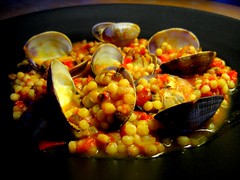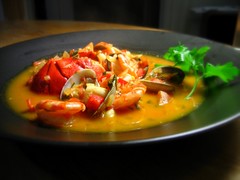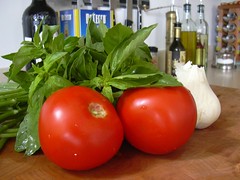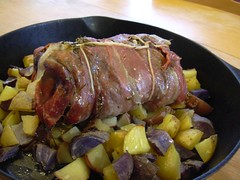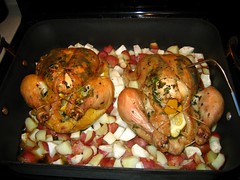
This is the recipe which Emily has dubbed Chicken with Herby Goodness. I developed it from a few Jamie Oliver recipes, the first of which was in The Naked Chef, a Jamie Oliver book. A few variations follow the recipe, but this is our favorite.
Chicken with Herby Goodness
One 2-3 pound free range chicken
3 handfuls of herbs (any 3 or 4 of thyme, basil, marjoram, and parsley)
2-3 bay leaves
1 lemon
1 lb potatoes, cut into 1/2" chunks
1 celery root, cut into 1/2" chunks
2 sprigs of rosemary
2 garlic cloves, crushed (don't bother removing the skin)
Preheat a roasting pan in the oven to 425 degrees.
Wash the chicken inside and out and pat dry. (If it came with extra bits, you can save it in the freezer for broth.) Rub some kosher salt on the inside of the chicken.
Chop up the herbs, mix in some salt, olive oil, and a little pepper. Gently separate the skin from the breasts of the chicken and stuff the herbs between the skin and the meat. Afterwards, try to make sure the skin covers all of the meat. Cut a couple of slashes into the legs and thighs (so heat can penetrate) and stuff the herbs under the skin and into the slashes. Rub some oil and salt on the outside of the chicken.
Cut the potatoes into 1/2" chunks, boil them for 5-10 min, along with the lemon.
Drain the potatoes. Take the lemon, stab it about 10 times with a knife, and stuff it into the middle of the chicken, along with the bay leaves, rosemary, and garlic cloves.
Put the potatoes and celery root into the pan, put the chicken on top, put a thermometer in the middle of the breast, and put it in the oven. (You can tie up the chicken if you wish.)
When the internal temperature reaches 155 degrees, take it out of the oven. Cover it with foil and let it rest for 10 minutes.
Carve the chicken and serve with the potatoes and chickeny rice. (I usually cut the breasts in half, and separate the legs from the thighs, so people can get a bit of each kind of meat.)
Chickeny Rice
1 cup rice
1 tbsp butter
2 cups chicken broth
1 small tomato chopped
1 tsp cumin seeds
1/2 small onion, chopped
Add a tablespoon of butter and about tablespoon of light olive oil to a pan on the stove over medium heat. Add the onions and cook the for 5-10 minutes, till they soften up. (Try not to burn the butter, the oil should help.) Add the rice and let it cook for a minute or so, while stirring. It should turn a little opaque. Add the tomatoes, and let them cook down for half a minute. Add the chicken broth, bring to a boil. Add the Bay leaf and rosemary sprig, stir once. Cover and reduce heat to low. Let it simmer for 15 minutes. Turn the heat off, and leave it covered for another 5 minutes.
Variations
If you want to reduce the prep/cooking time: instead of boiling the lemon, you can cut it into four chunks and stuff it in the chicken. Then put the chicken in the oven and start the potatoes. Pull the chicken out after 30 minutes, put the potatoes under the chicken, and put it back in the oven until it is done. (BTW, the easiest way I've found to pick up the chicken is to stick a fork in the cavity.)
For an alternative stuffing (under the skin), you can melt some butter (1/4 cup or so) mix in some thyme, lemon zest, and chopped up prosciutto.
